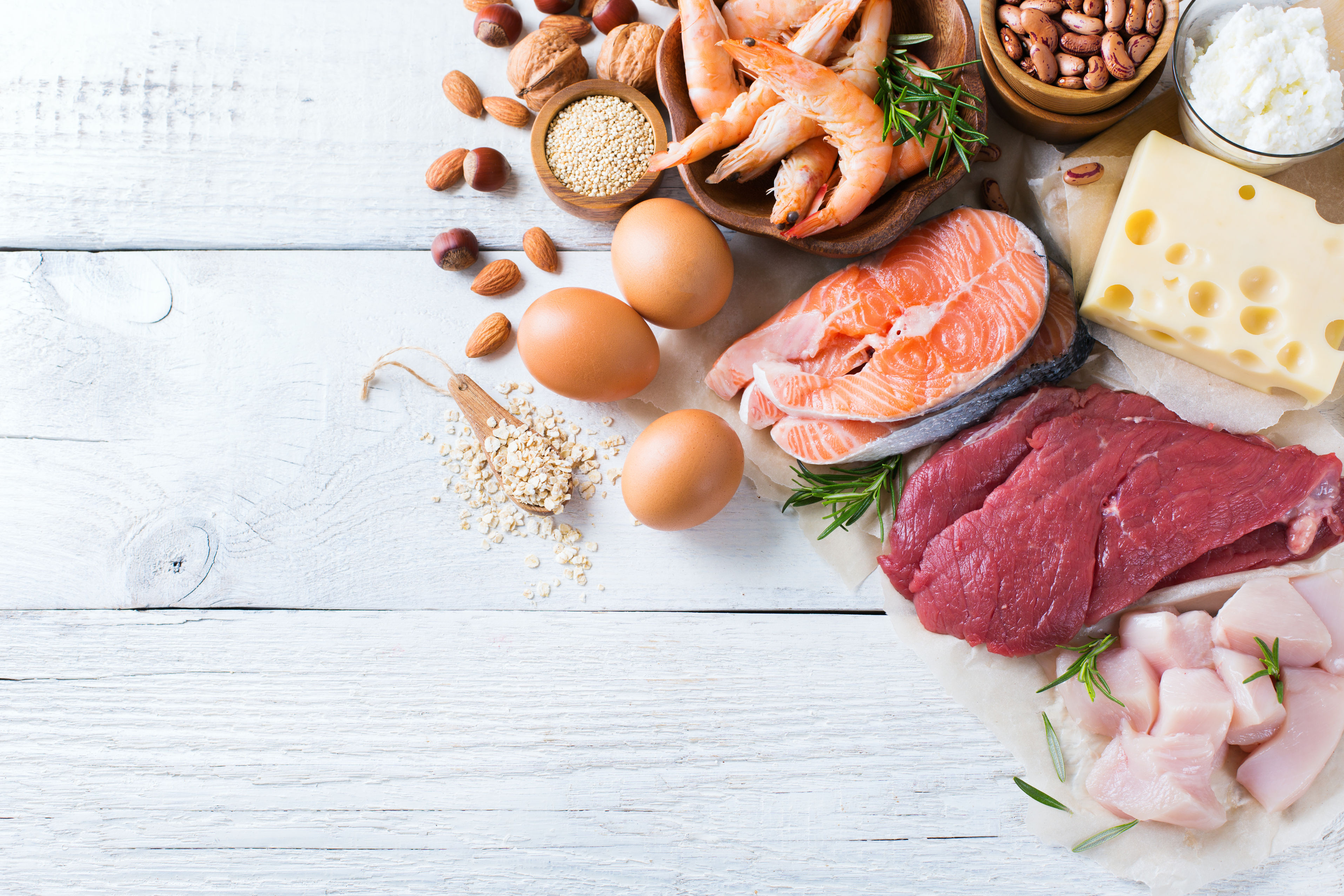Antibiotics
RIDASCREEN® Tetracyclin

Art. No.: R3505
Intended use:
RIDASCREEN® Tetracyclin is a competitive enzyme immunoassay for the quantitative analysis of tetracyclins in milk, milk powder, cheese, butter, dairy products (curd, yoghurt (plain/with fruits), kefir, cream, sour cream) honey, meat, sausage, fish, shrimp and whole egg.
General Information:
1948 aureomycin (chlortetracycline) was isolated by Duggan as a metabolite of the actinomyces species streptomycec aureofaciens. This was the first antibiotic substance of the group of tetracyclines. In Germany tetracycline, chlortetracycline and oxytetracycline are authorized for veterinary use. Therefore health risks for the consumer can occur. In all animal species which are used for food production tetracycline residues (the sum of mother substance and the 4-epimer) are limited in the EU law, commission regulation (EU) No 37/2010 with the following limits: 100 ppb in muscle and in milk.
Accessories:
RIDA® Tetracyclin Dotierlösung/Spiking Solution
Specifications
Art. No.: R3505
Test format: Microtiter plate with 96 wells (12 strips with 8 removable wells each)
Incubation time: 1 h 30 min
Contact Info
E-mail: info@chakmartin.com
Tel: 02-559-3936
Mobile: 089-892-2997
RIDASCREEN® Chloramphenicol

Art. No.: R1511
Intended use:
RIDASCREEN® Chloramphenicol is a competitive enzyme immunoassay for the quantitative analysis of chloramphenicol in milk, milk powder and dairy products, honey and royal jelly, meat, fish, shrimp, eggs, urine (also chloramphenicol glucuronide), plasma/serum and feed.
Accessories:
RIDA® Chloramphenicol Dotierlösung/Spiking Solution
Specifications
Art. No.: R1511
Test format: Microtiter plate with 96 wells (12 strips with 8 removable wells each)
Contact Info
E-mail: info@chakmartin.com
Tel: 02-559-3936
Mobile: 089-892-2997
RIDASCREEN® Sulfamethazin

Art. No.: R3011
Intended use:
RIDASCREEN® Sulfamethazin is a competitive enzyme immunoassay for the quantitative determination of sulfamethazine in milk, meat, honey, liver, kidney, fish, shrimp and egg.
General Information:
Sulfonamides are widely used as feed additives, mainly for fattening of calves and pigs. Combined with inhibitors of dihydrofolate reductase such as trimethoprim, tetroxoprim, or pyrimethamine sulfonamides are also used in veterinary medicine for the treatment of intestinal infections, mastitis, pneumonitis and other (systemic) diseases. Sulfonamide residues may therefore occur in food of animal origin such as meat and milk. Particularly the transmission of the carcinogenic sulfamethazine represents a threat to human health. The EU established a maximum residue limit (MRL) for all substances of the sulfonamide-group of 100 μg/kg (ppb) in muscle, fat, liver, kidney and milk.
Accessories:
RIDA® Sulfamethazin Dotierlösung/Spiking Solution
Specifications
Art. No.: R3011
Test format: Microtiter plate with 96 wells (12 strips with 8 removable wells each)
Incubation time: 45 min
Contact Info
E-mail: info@chakmartin.com
Tel: 02-559-3936
Mobile: 089-892-2997
RIDASCREEN® Streptomycin

Art. No.: R3104
Intended use:
RIDASCREEN® Streptomycin (Art. No.: R3104) is a competitive enzyme immunoassay for the quantitative analysis of stretomycin in milk and milk powder, honey, meat, liver, kidney, shrimp and apple juice.
General Information:
Next to the β-lactam antibiotics in veterinary medicine streptomycin is one of the mostly used antibiotics for the treatment of mastitis. Residues of streptomycin may therefore occur in food of animal origin, if the withholding period is not obeyed or if it is used improperly. High concentrations of streptomycin show ototoxic and nephrotoxic effects. The chronic exposure of humans with low concentrations, as found in food, may cause allergies, impair the intestinal flora and induce resistance of pathogenic microorganisms. To protect the consumer against health risks and avoid food-technological problems, a sensitive and simple method for the detection of streptomycin is necessary. The EU regulations for streptomycin are fixed in MRLs (maximum residue limits) for meat and milk (muscle and liver: 500 μg/kg, kidney: 1000 μg/kg and milk: 200 μg/l). In honey, the EU Community Reference Laboratories have determined a zero-tolerance with a minimum required performance limit of ccβ = 40 μg/kg for test systems.
Accessories:
RIDA® Streptomycin Dotierlösung/Spiking Solution
Specifications
Art. No.: R3104
Test format: Microtiter plate with 96 wells (12 strips with 8 removable wells each)
Incubation time: 45 min
Contact Info
E-mail: info@chakmartin.com
Tel: 02-559-3936
Mobile: 089-892-2997
RIDASCREEN® Bacitracin
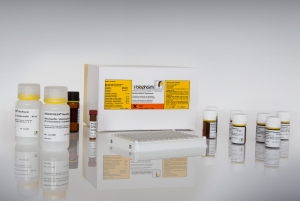
Art. No.: R2901
Intended use:
RIDASCREEN® Bacitracin is a competitive enzyme immunoassay for the quantitative analysis of bacitracin in milk, meat, eggs, feed and urine
General Information:
Bacitracin belongs to the group of polypeptide antibiotics. It was named after the Bacillus strain producing it and the 7 year old girl ‘Tracy’ from whose open tibial fracture the strain was isolated in 1945 for the first time. Bacitracin is a mixture of different polypeptides, wherein bacitracin A as major component has the highest biological activity. Through inhibition of cell wall synthesis, it has a broad spectrum bactericidal effect against both gram-positive and gram-negative bacteria.
In addition to veterinary application, bacitracin can be used as antimicrobial growth promoter in animal husbandry. Thereby, residues can remain in foodstuff of animal origin and may pose a health risk to consumers. Improper use of antibiotics also promotes the formation of antibiotic resistant bacteria, which raise an increasing health problem for the population. Consequently, Bacitracin has been deleted by the regulation 2821/98/EC from the list of approved animal feed additives (Directive 70/524/EEG Appendix B) and maximum residue limits in foodstuffs have been set (Regulation 37/2010/EC).
Specifications
| Art. No. | R2901 |
| Test Format | Microtiter plate with 96 wells (12 strips with 8 removable wells each) |
| Sample Preparation | milk: pH-adjustment, defatting, dilution meat, eggs and feed: homogenization, extraction, centrifugation, dilution urine: dilution |
| Incubation Time | 1.5 h |
| Detection Limit | milk: approx. 11 µg/kg (ppb) meat: approx. 9 µg/kg (ppb) eggs: approx. 11 µg/kg (ppb) feed: approx. 82 µg/kg (ppb) urine : approx. 23 µg/kg (ppb)(corresponding to the standard substance) |
| Cross Reactivity | Bacitracin (standard substance) : 100% Virginiamycin: < 3 % Tylosin: < 2 % Spiramycin, Neomycin, Colistin: < 1 % |
Contact Info
E-mail: info@chakmartin.com
Tel: 02-559-3936
Mobile: 089-892-2997
RIDASCREEN® Sulfonamide
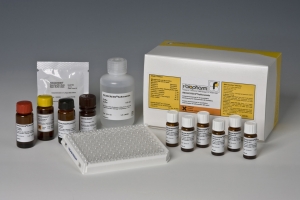
Art. No.: R3004
Intended use:
RIDASCREEN® Sulfonamide is a competitive enzyme immunoassay for the quantitative analysis of sulfonamides in egg, meat (chicken and pork), fish, shrimp, honey and milk.
General Information:
Sulfonamides are widely used as feed additives, mainly for fattening of calves and pigs. Combined with inhibitors of dihydrofolate reductase such as trimethoprim, tetroxoprim, or pyrimethamine sulfonamides are also used in veterinary medicine for the treatment of intestinal infections, mastitis, pulmonitis and other (systemic) diseases. Therefore sulfonamide residues may occur in food of animal origin such as meat and milk and were found frequently abroad. According to the EU-Law a maximum residue limit for all substances of the sulfonamide-group of 100 µg/kg in muscle, fat, liver and kidney and of 100 µg/l in milk is valid.
Specifications
| Art. No. | R3004 |
| Test Format | Microtiter plate with 96 wells (12 strips with 8 removable wells each) |
| Sample Preparation | milk: after 1:5 dilution direct use in the assay meat (chicken and pork), egg, fish, shrimp: homogenization, extraction, centrifugation, evaporation and degreasing honey: extraction, RIDA® C18 column purification and dilution |
| Incubation Time | 1h15min |
| Detection Limit | meat (chicken), egg: 1.5 µg/kg (ppb) meat (pork), fish, shrimp, honey: 2 µg/kg (ppb) milk: 3.5 µg/l (ppb) (corresponding to the standard substance) |
| Cross Reactivity | Sulfamethoxypyridazine: approx. 100% Sulfapyridine: > 100% Sulfamethoxydiazine: approx. 75% Sulfamethoxazole: approx. 58% Sulfadimethoxine: approx. 41% Sulfaquinoxaline: approx. 34% Sulfachloropyridazine: approx. 19% Sulfamerazine: approx. 18% Sulfadiazine: approx. 15% Sulfamethizole: approx. 14% Sulfadoxine: approx. 10% Sulfachloropyrazine: approx. 9% Sulfaguanidine: approx. 5% Sulfaphenazole, Sulfamethazine, Sulfisoxazole, Sulfanilamide: approx. 2% Sulfacetamide: approx. 1% |
Contact Info
E-mail: info@chakmartin.com
Tel: 02-559-3936
Mobile: 089-892-2997
– RIDASCREEN® Nitrofuran (SEM)
RIDASCREEN® Nitrofuran (SEM)

Art. No.: R3715
Intended use:
RIDASCREEN® Nitrofuran (SEM) is a competitive enzyme immunoassay for the quantitative analysis of SEM in shrimp, meat (chicken, pork, beef) and fish.
General Information:
Nitrofurans are synthetic broad-spectrum antibiotics, which are frequently used in animal production due to their excellent antibacterial and pharmacokinetic properties. They have also been used as growth promoters during the production of shrimp, poultry and pigs. Long term animal experiments have shown that the parent compounds and their metabolites have carcinogenic and mutagenic characteristics. This led to the prohibition of nitrofurans for the treatment of animals used for food production. In 1993, the EU banned the nitrofurans furaltadone, nitrofurantoin and nitrofurazone for use in animals used as sources of food, and in 1995 the use of furazolidone was also prohibited.
The analysis of nitrofurans are based on the detection of the tissue bound metabolites of nitrofurans. The parent compounds are difficult to detect accurately since they are metabolized very rapidly after treatment. The tissue bound nitrofuran metabolites however are present for a long time after administration and they are used to detect nitrofuran abuse. Prior to analysis, the metabolites have to be derivatized by incubation with 2-Nitrobenzaldehyde (2NBA) into Nitrophenyl-(NP) AHD, NP-AMOZ, NP-AOZ and NP-SEM.
parent compound / metabolite / after derivatization
Nitrofurantoin / 1-Aminohydantoin – AHD /NP-AHD
Furaltadon / 3-Amino-5-morpholinomethyl-2-oxazolidinon – AMOZ / NP-AMOZ
Furazolidon / 3-Amino-2-oxazolidinon – AOZ /NP-AOZ
Nitrofurazon / Semicarbazide – SEM / NP-SEM
Accessories:
RIDA® Nitrofuran SEM Spiking Solution
Specifications
| Art. No. | R3715 |
| Test Format | Microtiter plate with 96 wells (12 strips with 8 removable wells each) |
| Sample Preparation | homogenization, derivatization, extraction, centrifugation, evaporation and defatting
Detailed Application Notes for fish and shrimp, describing each an uniform sample preparation with the ability to analyze the same sample extract in all 4 RIDASCREEN® Nitrofuran ELISA tests, are available on request. |
| Incubation Time | 1h15min |
| Detection Limit | Shrimp: approx. 300 ng/kg (ppt) Meat (beef, pork): approx. 300 ng/kg (ppt) Fish: approx. 360 ng/kg (ppt) Meat (chicken): approx. 400 ng/kg (ppt)(corresponding to the standard substance) |
| Cross Reactivity | Nitrophenyl- (NP) SEM (standard substance): 100% AMOZ, AOZ, AHD: < 0.01% Nitrofurazon: approx. 7% Furaltadon, Furazolidon: < 0.01% |
Contact Info
E-mail: info@chakmartin.com
Tel: 02-559-3936
Mobile: 089-892-2997
– RIDASCREEN® Nitrofuran (AHD)
RIDASCREEN® Nitrofuran (AHD)
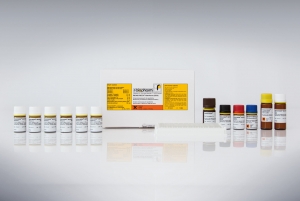
Art. No.: R3713
Intended use:
RIDASCREEN® Nitrofuran (AHD) is a competitive enzyme immunoassay for the quantitative analysis of the nitrofurantoin metabolite AHD in shrimp and fish.
General Information:
Nitrofurans are synthetic broad-spectrum antibiotics, which are frequently used in animal production due to their excellent antibacterial and pharmacokinetic properties. They have also been used as growth promoters during the production of shrimp, poultry and pigs. Long term animal experiments have shown that the parent compounds and their metabolites have carcinogenic and mutagenic characteristics. This led to the prohibition of nitrofurans for the treatment of animals used for food production. In 1993, the EU banned the nitrofurans furaltadone, nitrofurantoin and nitrofurazone for use in animals used as sources of food, and in 1995 the use of furazolidone was also prohibited.
The analysis of nitrofurans is based on the detection of the tissue bound metabolites of nitrofurans. The parent compounds are difficult to detect accurately since they are metabolized very rapidly after treatment. The tissue bound nitrofuran metabolites however are present for a long time after administration and they are used to detect nitrofuran abuse. Prior to analysis, the metabolites have to be derivatized by incubation with 2-Nitrobenzaldehyde (2NBA) into Nitrophenyl-(NP) AHD, NP-AMOZ, NP-AOZ and NP-SEM.
parent compound / metabolite (abbreviation) / after derivatizaton
Nitrofurantoin / 1-Aminohydantoin (AHD) / NP-AHD
Furaltadone / 3-Amino-5-morpholinomethyl-2-oxazolidinone (AMOZ) / NP-AMOZ
Furazolidone / 3-Amino-2-oxazolidinone (AOZ) / NP-AOZ
Nitrofurazone / Semicarbazide (SEM) / NP-SEM
Accessories:
RIDA® Nitrofuran AHD Spiking Solution
Specifications
| Art. No. | R3713 |
| Test Format | Microtiter plate with 96 wells (12 strips with 8 removable wells each) |
| Sample Preparation | homogenization, derivatization, extraction, centrifugation, evaporation and defatting
A detailed Application Note, describing an uniform sample preparation for shrimp and fish with the ability to analyze the same sample extract in all 4 RIDASCREEN® Nitrofuran ELISA tests, is available on request. |
| Incubation Time | 1h15min |
| Detection Limit | Shrimp: approx. 200 ng/kg (ppt) Fish: approx. 76 ng/kg (ppt)(corresponding to the standard substance) |
| Cross Reactivity | Nitrophenyl- (NP) AHD: 100% NP-AMOZ, NP-AOZ, NP-SEM: < 1% Nitrofurantoine : approx. 32% Furaltadone, Furazolidone, Nitrofurazone: < 2% AHD, AMOZ, AOZ, SEM: < 1% |
Contact Info
E-mail: info@chakmartin.com
Tel: 02-559-3936
Mobile: 089-892-2997
– RIDASCREEN® Nitrofuran (AMOZ)
RIDA® Nitrofuran (AMOZ)
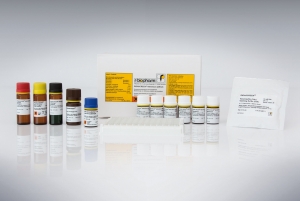
Art. No.: R3711
Intended use:
RIDASCREEN® Nitrofuran (AMOZ) is a competitive enzyme immunoassay for the quantitative analysis of AMOZ in shrimps, meat (chicken, pork, beef), liver (beef and pork), fish and whole egg.
General Information:
Nitrofurans are synthetic broad-spectrum antibiotics, which are frequently used in animal production due to their excellent antibacterial and pharmacokinetic properties. They have also been used as growth promoters during the production of shrimps, poultry and pigs. Long term animal experiments have shown that the parent compounds and their metabolites have carcinogenic and mutagenic characteristics. This led to the prohibition of nitrofurans for the treatment of animals used for food production. In 1993, the EU banned the nitrofurans furaltadone, nitrofurantoin and nitrofurazone for use in animals used as sources of food, and in 1995 the use of furazolidone was also prohibited. The analysis of nitrofurans are based on the detection of the tissue bound metabolites of nitrofurans. The parent compounds are difficult to detect accurately since they are metabolized very rapidly after treatment. The tissue bound nitrofuran metabolites however are present for a long time after administration and they are used to detect nitrofuran abuse.
Parent compound / Metabolite / Abbreviation
Nitrofurantoin / 1-Aminohydantoin / AHD
Furaltadone / 3-Amino-5-morpholinomethyl-2-oxazolidinone / AMOZ
Furazolidone / 3-Amino-2-oxazolidinone / AOZ
Nitrofurazone / Semicarbazide / SEM
Prior to analysis, the metabolites have to be derivatized by incubation with 2-Nitrobenzaldehyde into NP-AHD, NP-AMOZ, NP-AOZ and NP-SEM.
Accessories:
RIDA® Nitrofuran (AMOZ) Dotierlösung/Spiking Solution
Specifications
| Art. No. | R3711 |
| Test Format | Microtiter plate with 96 wells (12 strips with 8 removable wells each) |
| Sample Preparation | homogenization, derivatisation, extraction, centrifugation, evaporation and degreasing
Further Application Notes (for example for shrimp to analyze the same sample extract in all 4 RIDASCREEN® Nitrofuran ELISA tests) are available on request. |
| Incubation Time | 1h15min |
| Detection Limit | Shrimp, meat, liver, fish, whole egg: approx. 200 ng/kg (ppt)
(corresponding to the standard substance) |
| Cross Reactivity | NP-AMOZ: 100 % AOZ, AHD, SEM: < 0,05 % |
Contact Info
E-mail: info@chakmartin.com
Tel: 02-559-3936
Mobile: 089-892-2997
– RIDASCREEN® Nitrofuran (AOZ)
RIDASCREEN® Nitrofuran (AOZ)

Art. No.: R3703
Intended use:
RIDASCREEN® Nitrofuran (AOZ) is a competitive enzyme immunoassay for the quantitative analysis of AOZ in shrimp, meat (chicken, pork, beef), liver (beef and pork), fish, whole egg and milk.
General Information:
Nitrofurans are synthetic broad-spectrum antibiotics, which are frequently used in animal production due to their excellent antibacterial and pharmacokinetic properties. They have also been used as growth promoters during the production of shrimp, poultry and pigs. Long term animal experiments have shown that the parent compounds and their metabolites have carcinogenic and mutagenic characteristics. This led to the prohibition of nitrofurans for the treatment of animals used for food production. In 1993, the EU banned the nitrofurans furaltadone, nitrofurantoin and nitrofurazone for use in animals used as sources of food, and in 1995 the use of furazolidone was also prohibited. The analysis of nitrofurans are based on the detection of the tissue bound metabolites of nitrofurans. The parent compounds are difficult to detect accurately since they are metabolized very rapidly after treatment. The tissue bound nitrofuran metabolites however are present for a long time after administration and they are used to detect nitrofuran abuse.
Prior to analysis, the metabolites have to be derivatized by incubation with 2-Nitrobenzaldehyde into NP-AHD, NP-AMOZ, NP-AOZ and NP-SEM.
Accessories:
RIDA® Nitrofuran (AOZ) Dotierlösung/Spiking Solution
Specifications
| Art. No. | R3703 |
| Test Format | Microtiter plate with 96 wells (12 strips with 8 removable wells each) |
| Sample Preparation | Homogenization, derivatisation, extraction, centrifugation, evaporation and degreasing. Further application notes are available on request. |
| Incubation Time | 1h15min |
Contact Info
E-mail: info@chakmartin.com
Tel: 02-559-3936
Mobile: 089-892-2997
– RIDASCREEN® Chinolone/Quinolones
RIDASCREEN® Chinolone/Quinolones

Art. No.: R3113
Intended use:
RIDASCREEN® Chinolone is a competitive enzyme immunoassay for the quantitative analysis of chinolones in egg, beef, pork, sheep, chicken, turkey, fish and shrimp.
General Information:
Gyrase inhibitors are devided into four subgroups. The majority of chinolones belong to the subgroup of fluorochinolones, which have a fluoro-group attached at the central ring system, typically at the 6th position. The fluorchinolones belong to the so called second generation chinolones. Some of these are admitted as antibiotics in veterinary medicine for food producing animals. Fluorchinolones are broad spectrum antibiotics against a lot of bacterial species. They are used frequently in veterinary medicine especially for cattle, pigs and chicken. The usage of fluorchinolone has increased in the past years because large amounts of fluorchinolones were applied to prevent infectious diseases, especially in chicken, swine and fish/shrimp farming. The wide use in food producing animals has generated microbial resistances. This led to an amendment of Council Regulation (EEC) No 2377/90 and in the introduction of MRLs (Maximum Residue Limits) for some fluorchinolones.
Specifications
| Art. No. | R3113 |
| Test Format | Microtiter plate with 96 wells (12 strips with 8 removable wells each) |
| Incubation Time | 1h15min |
Contact Info
E-mail: info@chakmartin.com
Tel: 02-559-3936
Mobile: 089-892-2997
Hormones & Anabolics
RIDASCREEN® Clenbuterol

Art. No.: R1711
Intended use:
RIDASCREEN® Clenbuterol (Art. No.: R1711) is a competitive enzyme immunoassay for the quantitative analysis of clenbuterol in milk, meat, liver, kidney, urine, plasma/serum, hair, eyeball and feed
Accessories:
RIDA® ß-Agonists Clenbuterol-Dotierlösung/Spiking Solution
RIDA® Clenbuterol Assay Control (positive) for RIDASCREEN® Clenbuterol (R1711)
RIDA® Clenbuterol Assay Control (negative) for RIDASCREEN® Clenbuterol (R1711)
Specifications
Art. No.: R1711
Test format: Microtiter plate with 96 wells (12 strips with 8 removable wells each)
Contact Info
E-mail: info@chakmartin.com
Tel: 02-559-3936
Mobile: 089-892-2997
RIDASCREEN® β-Agonists

Art. No.: R1704
Intended use:
RIDASCREEN® β-Agonists is a competitive enzyme immunoassay for the quantitative analysis of β-Agonists in urine, serum, meat, liver, milk and feed.
Accessories:
RIDA® ß-Agonists Clenbuterol-Dotierlösung/Spiking Solution
Specifications
Art. No.: R1704
Test format: Microtiter plate with 96 wells (12 strips with 8 removable wells each)
Contact Info
E-mail: info@chakmartin.com
Tel: 02-559-3936
Mobile: 089-892-2997
RIDASCREEN® Zeranol

Art. No.: R3301
Intended use:
RIDASCREEN® Zeranol is a competitive enzyme immunoassay for the quantitative analysis of zeranol in urine.
General Information:
The oestrogenic anabolic agent zeranol (a-Zearalanol) is derived from the mycotoxin zearalenone. It is used to increase the average daily live-weight gain in ruminants and to improve the food conversion efficiency. However, this compound has not been authorized as fattening adjuvant in the EU.
The synthetic compound zeranol possesses about three times the estrogenic activity of zearalenone. Besides its anabolic effects, zeranol causes the clinical signs of hyperestrogenism, particularly reduced fertility and disorders in development. It is thus not impossible that zeranol residues in edible tissues, after use in illegal practice, may lead to a risk for consumers.
Accessories:
RIDA® Zeranol Dotierlösung/Spiking Solution
Specifications
| Art. No. | R3301 |
| Test Format | Microtiter plate (12 strips with 8 removable wells each) |
| Sample Preparation | hydrolysis and chromatographic purification by means of RIDA® C18 columns (Art. Nr. R2002) |
| Incubation Time | 1h15min |
| Detection Limit | 1.5 µg/l (ppb) (the standard range in consideration of the dilution factor is 200 – 16200 ng/l (ppt))(corresponding to the standard substance) |
| Cross Reactivity | Zeranol: 100 % Zearalanone: approx. 2 % ß-Zearalanol: approx. 4 % Zearalenone: < 0.5 % α-Zearalenol: approx. 21 % ß-Zearalenol: approx. 2.5 % 17ß-Estradiol: < 0.02 % Clenbuterol: < 0.02 % Testosterone: < 0.02 % |
Contact Info
E-mail: info@chakmartin.com
Tel: 02-559-3936
Mobile: 089-892-2997
RIDASCREEN® Trenbolon

Art. No.: R2601
Intended use:
RIDASCREEN® Trenbolon is a competitive enzyme immunoassay for the quantitative analysis of trenbolone in urine, bile, meat, liver and feces.
General Information:
Trenbolone acetate is a very efficient anabolic steroid with strong androgenic activity. Genotoxic activity has not yet been found in residues after proper use of trenbolone. However, trenbolone in increased concentrations induced cell transformation in a test using “syrian hamster embryonal cells”, and reacted weakly positive in the Ames-test.
Accessories:
RIDA® Trenbolon Dotierlösung/Spiking Solution
RIDA® Trenbolon Assay Control (positive)
Trenbolon Assay Control (negative)
Specifications
| Art. No. | R2601 |
| Test Format | Microtiter plate with 96 wells (12 strips with 8 removable wells each) |
| Sample preparation | Hydrolysis, Chromatographic prepurification using RIDA® C18 column (Art. No.: R2002) |
| Incubation Time | 1h15min |
Contact Info
E-mail: info@chakmartin.com
Tel: 02-559-3936
Mobile: 089-892-2997
RIDASCREEN® Testosteron

Art. No.: R2401
Intended use:
RIDASCREEN® Testosteron is a competitive enzyme immunoassay for the quantitative analysis of testosterone in bovine plasma.
Accessories:
RIDA® Testosteron Dotierlösung/Spiking Solution
Specifications
Art. No.: R2401
Test format: Microtiter plate with 96 wells (12 strips with 8 removable wells each)
Contact Info
E-mail: info@chakmartin.com
Tel: 02-559-3936
Mobile: 089-892-2997
RIDASCREEN® Ractopamin

Art. No.: R9901
Intended use:
RIDASCREEN® Ractopamin is a competitive enzyme immunoassay for the quantitative analysis of ractopamine in urine, meat and liver and for the qualitative analysis of ractopamin glucuronide in urine.
Accessories:
RIDA® Ractopamin Dotierlösung/Spiking Solution
Specifications
Art. No.: R9901
Test format: Microtiter plate with 96 wells (12 strips with 8 removable wells each)
Contact Info
E-mail: info@chakmartin.com
Tel: 02-559-3936
Mobile: 089-892-2997
– RIDASCREEN® Methyltestosteron
RIDASCREEN® Methyltestosteron

Art. No.: R3611
Intended Use
RIDASCREEN® Methyltestosteron is a competitive enzyme immunoassay for the quantitative analysis of methyltestosterone in urine (porcine, bovine), meat (pork, beef), fish (salmon, pangasius, tilapia, trout, catfish) and liver (porcine, bovine).
General Information
The anabolic effects of methyltestosterone are comparable to those of testosterone, which is a natural male sexual hormone. Methyltestosterone is a synthetic steroid hormone and as testosterone illegally used in cattle fattening.
Accessories
RIDA® Methyltestosteron Dotierlösung/Spiking Solution
Specifications
Art. No. : R3611
Test format: Microtiter plate with 96 wells (12 strips with 8 removable wells each)
Incubation time approx.: 2 h 15 min
Contact Info
E-mail: info@chakmartin.com
Tel: 02-559-3936
Mobile: 089-892-2997
– RIDASCREEN® Melengestrolacetat
RIDASCREEN® Melengestrolacetat
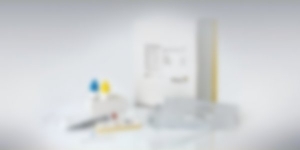
Art. No.: R6502
Intended use
RIDASCREEN® Melengestrolacetat is a competitive enzyme immunoassay for the quantitative analysis of melengestrol acetate in bovine perirenal fat and muscle meat. The performance of the test is adjusted to the current legal demands and well suited for the control of meat exported by the USA and Canada.
Accessories
RIDA® Melengestrolacetat Dotierlösung/Spiking Solution
Specifications
Art. No.: R6502
Test format: Microtiter plate with 96 wells (12 strips with 8 removable wells each)
Contact Info
E-mail: info@chakmartin.com
Tel: 02-559-3936
Mobile: 089-892-2997
– RIDASCREEN® Ethinylöstradiol
RIDASCREEN® Ethinylöstradiol

Art. No.: R2511
Intended use
RIDASCREEN® Ethinylöstradiol is a competitive enzyme immunoassay for the quantitative analysis of ethinylestradiol residues in urine, meat and plasma.
General Information
Ethinylestradiol is a synthetic sexual hormone which is, like all other natural or synthetic steroid hormones, prohibited for use as resource in fattening in the European Community since 1988.
Accessories
RIDA® Ethinylöstradiol Dotierlösung/Spiking Solution
Specifications
Art. No.: R2511
Test Format: Microtiter plate with 96 wells (12 strips with 8 removable wells each)
Incubation Time: 2 h 30 min
Contact Info
E-mail: info@chakmartin.com
Tel: 02-559-3936
Mobile: 089-892-2997
RIDASCREEN® Acetylgestagene

Art. No.: R1801
Intended Use
RIDASCREEN® Acetylgestagene is a competitive enzyme immunoassay for the quantitative analysis of medroxyprogesterone acetate (MPA) and other acetylgestagenes in bovine perirenal fat.
Accessories
RIDA® Acetylgestagene Dotierlösung/Spiking Solution
Specifications
Art. No.: R1801
Test format: Microtiter plate with 96 wells (12 strips with 8 removable wells each)
Contact Info
E-mail: info@chakmartin.com
Tel: 02-559-3936
Mobile: 089-892-2997
– RIDASCREEN® 19-Nortestosteron
RIDASCREEN® 19-Nortestosteron

Art. No.: R2801
Intended Use
RIDASCREEN® 19-Nortestosteron is a competitive enzyme immunoassay for the quantitative analysis of of 19-nortestosterone in urine.
General Information
The anabolic effects of 19-Nortestosterone are comparable to those of testosterone, but with less androgenic effects. In Germany, 19-Nortestosterone-decanoate and -laureate are permitted for veterinary use. However, the illegal use of 19-Nortestosterone as doping agents in high performance sports or horse sports are far more common. Some years ago the increasing application of illegal cocktails as a fattening resource in calf fattening was reported. Those cocktails usually contained 19-Nortestosterone-ester.
Accessories
RIDA® 19-Nortestosteron Dotierlösung/Spiking Solution
Specifications
| Art. No. | R2801 |
| Test Format | Microtiter plate with 96 wells (12 strips with 8 removable wells each) |
| Sample Preparation | hydrolysis and chromatographic purification with RIDA® C18 columns (Art. No.: R2002) |
| Incubation Time | 1h15min |
| Detection limit | 3 µg/l (ppb) (the measuring range in consideration of the dilution factor is 100 – 6000 ng/lppt)(corresponding to the standard substance) |
| Cross reactivity | 19-Nortestosterone 17β (standard substance): 100 % 19-Nortestosterone 17α: approx. 80 % 19-Norethisterone: approx. 74 % 19-Norandrostendione: approx.100 % 18-Methyl-19 NT-17β: approx. 59 % 17α-Ethyl-19 NT-17β: approx. 40 % 15α, 16α-Methyl.-19 NT-17β-acetate: approx. 71 % Trenbolone: approx. 10 % 17β-Estradiol: approx. 0.1 Zeranol: < 0.1 % DES: < 0.1 % MPA: < 0.1 % |
Contact Info
E-mail: info@chakmartin.com
Tel: 02-559-3936
Mobile: 089-892-2997
RIDASCREEN® 17β-Östradiol

Art. No.: R2301
Intended Use
RIDASCREEN® 17ß-Östradiol is a competitive enzyme immunoassay for the quantitative analysis of 17ß-estradiol in bovine plasma.
Accessories
RIDA® 17ß-Östradiol Dotierlösung/Spiking Solution
Specifications
Art. No.: R2301
Test Format: Microtiter plate with 96 wells (12 strips with 8 removable wells each)
Contact Info
E-mail: info@chakmartin.com
Tel: 02-559-3936
Mobile: 089-892-2997
Antibiotics
Premi®Test Urin

Art. No.: R3921
Intended use
Premi®Test Urin is a reagent that enables bovine/porcine urine to be tested for antibiotic residues with Premi®Test.
Specifications
| Art. No. | R3921 |
| Test Format | Premi®Test Urine contains 1 dropping bottle with 15 ml of sample buffer. The number of samples which can be prepared is dependent on the volume of the samples. Exemplarily, 30 samples with a volume of 30 ml each. |
| Sample Preparation | For the preparation of urine samples, Premi®Test Urine is simply dripped into the urine sample. After mixing, the sample can be applied directly to Premi®Test (Art. No. R3925/R3900) for the screening of antibiotic residues. |
Contact Info
E-mail: info@chakmartin.com
Tel: 02-559-3936
Mobile: 089-892-2997
Premi®Test 25
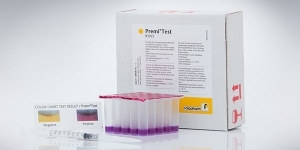
Art. No.: R3925
Intended Use
Premi®Test is a microbial screening test for the detection of antibiotic residues in food and feed in less than 4 hours.
Premi®Test allows to screen meat (beef, pork, poultry), fish, shrimps, eggs, liver, kidney, urine and feed for the residues of β-lactams, Cephalosporines, Macrolides, Tetracyclines, Sulphonamides, Aminoglycosides, Quinolones, Amphenicoles and Polypeptides.
PremiTest is a ‘Performance Tested Method’ of the AOAC Research Institute for the screening of Penicillin in bovine meat (060601) and holds the ‘VALIDATION NF’ by AFNOR for the screening of β-lactams, Macrolides, Tetracyclines, Sulphonamides in beef, pork and poultry (RBP 31/02 – 04/11).
General Information
Treatment of farm animals with veterinary pharmaceuticals such as antibiotics leads to drug residues in the tissues of the animals and establishes a health risk for the consumers of animal food products. Premi®Test is an easy antibiotics residue screening test which allows fast screening of food products by all members of the food production chain such as farmers, slaughterhouses, meat-processors and analytical laboratories.
The test is based on the inhibition of the growth of Bacillus stearothermophilus, a thermophilic bacterium which is very sensitive to many antibiotics and sulpha compounds. A standardised number of spores are imbedded in agar medium containing selected nutrients. When Premi®Test is heated at 64 °C, the spores will germinate. If no inhibitory substances are present the germinated spores will multiply with the production of acid. This will be visible by a colour change from purple to yellow. When anti-microbial compounds are present in sufficient amount (above the detection limit) the spores will be unable to germinate and therefore no colour change will be observed.
Specifications
| Art. No. | R3925 |
| Test Format | 25 ampoules |
| Sample Preparation | Meat (beef, pork, poultry): extraction of meat juice using a ‘meat press’ (contained in thePremi®Test Starter Kit ZPT-2000). More sample preparation protocols are available for the analysis of antibiotic residues in fish, shrimps, eggs, liver, kidney, plasma/serum, urine from cattle/pork and feed for swine/poultry. Incubation time Approximately 3 hours |
| Incubation time | Approximately 3 hours |
| Detection limit | In line with EU Maximum Residue Limits (MRL’s). |
| Approvals | – AOAC-RI (060601) – AFNOR VALIDATION NF (RBP31/02 – 04/11) |
Contact Info
E-mail: info@chakmartin.com
Tel: 02-559-3936
Mobile: 089-892-2997
Premi®Test 4×25

Art. No.: R3925
Intended Use
Premi®Test is a microbial screening test for the detection of antibiotic residues in food and feed in less than 4 hours.
Premi®Test allows to screen meat (beef, pork, poultry), fish, shrimps, eggs, liver, kidney, urine and feed for the residues of β-lactams, Cephalosporines, Macrolides, Tetracyclines, Sulphonamides, Aminoglycosides, Quinolones, Amphenicoles and Polypeptides.
PremiTest is a ‘Performance Tested Method’ of the AOAC Research Institute for the screening of Penicillin in bovine meat (060601) and holds the ‘VALIDATION NF’ by AFNOR for the screening of β-lactams, Macrolides, Tetracyclines, Sulphonamides in beef, pork and poultry (RBP 31/02 – 04/11).
General Information
Treatment of farm animals with veterinary pharmaceuticals such as antibiotics leads to drug residues in the tissues of the animals and establishes a health risk for the consumers of animal food products. Premi®Test is an easy antibiotics residue screening test which allows fast screening of food products by all members of the food production chain such as farmers, slaughterhouses, meat-processors and analytical laboratories.
The test is based on the inhibition of the growth of Bacillus stearothermophilus, a thermophilic bacterium which is very sensitive to many antibiotics and sulpha compounds. A standardised number of spores are imbedded in agar medium containing selected nutrients. When Premi®Test is heated at 64 °C, the spores will germinate. If no inhibitory substances are present the germinated spores will multiply with the production of acid. This will be visible by a colour change from purple to yellow. When anti-microbial compounds are present in sufficient amount (above the detection limit) the spores will be unable to germinate and therefore no colour change will be observed.
Specifications
| Art. No. | R3900 |
| Test Format | 25 ampoules |
| Sample Preparation | Meat (beef, pork, poultry): extraction of meat juice using a ‘meat press’ (contained in thePremi®Test Starter Kit ZPT-2000). More sample preparation protocols are available for the analysis of antibiotic residues in fish, shrimps, eggs, liver, kidney, plasma/serum, urine from cattle/pork and feed for swine/poultry. Incubation time Approximately 3 hours |
| Incubation time | Approximately 3 hours |
| Detection limit | In line with EU Maximum Residue Limits (MRL’s). |
| Approvals | – AOAC-RI (060601) – AFNOR VALIDATION NF (RBP31/02 – 04/11) |
Contact Info
E-mail: info@chakmartin.com
Tel: 02-559-3936
Mobile: 089-892-2997
Antibiotics
RIDA® C18 column

Art. No.: R2002
Intended Use
The solid phase extraction (SPE) with RIDA® C18 columns is an efficient technique for a fast and selective sample preparation, especially for the RIDASCREEN® anabolic- and hormone enzyme immunoassays.
General Information
A solid phase extraction procedure normally consists of 5 steps:
− sample pre-treatment (extraction and conditioning of the extract)
− column solvation and pre-equilibration
− sample application
− elution of interfering matrix components / rinsing of the column
− elution of the analyte
Specifications
Art. No. : R2002
Test format: 100 x C18 columns (100 mg/ml column reservoir) with 100 mg end-capped sorbent (octadecyl sorbent)
Contact Info
E-mail: info@chakmartin.com
Tel: 02-559-3936
Mobile: 089-892-2997
Hormones & Anabolics
– EASI-EXTRACT® CHLORAMPHENICOL
EASI-EXTRACT® CHLORAMPHENICOL

Art. No.: P300 / P300B
Intended Use
Immunoaffinity columns for use in conjunction with an HPLC or LC-MS/MS system for detection of chloramphenicol in a wide range of commodities.
The columns contain a gel suspension of monoclonal antibody specific to the antibiotic of interest. The sample is diluted with buffer, vortexed (or placed on an orbital shaker), filtered and passed slowly through the immunoaffinity column. Any antibiotic which is present in the sample is retained by the antibody within the gel suspension. The column is washed to remove unbound material and the antibiotic is then released from the column following elution with solvent. The eluate is collected, evaporated and reconstituted prior to analysis by HPLC or LC-MS/MS.
General Information
The procedure is based on monoclonal antibody technology, which makes the test highly specific, sensitive, rapid and simple to perform. Improved clean-up and concentration of toxins from complex food matrices results in reduced chromatography interference and lower detection limits.
Specifications
| Art. No. | P300 / P300B |
| Test Format | 10 wide format immunoaffinity columns (P300). 50 wide format immunoaffinity columns (P300B). |
| Detection limit | HPLC: 20 ng/ml of chloramphenicol. LC-MS/MS: 0.02 ng/ml of chloramphenicol. |
Contact Info
E-mail: info@chakmartin.com
Tel: 02-559-3936
Mobile: 089-892-2997

